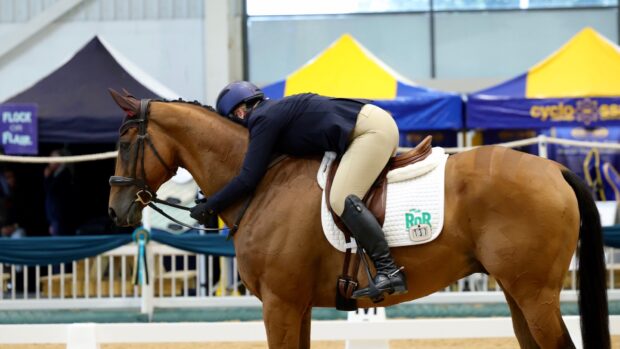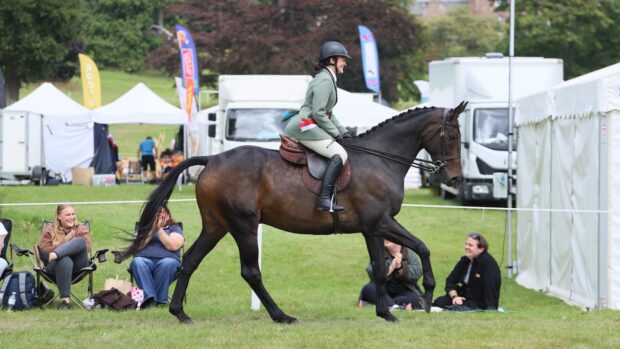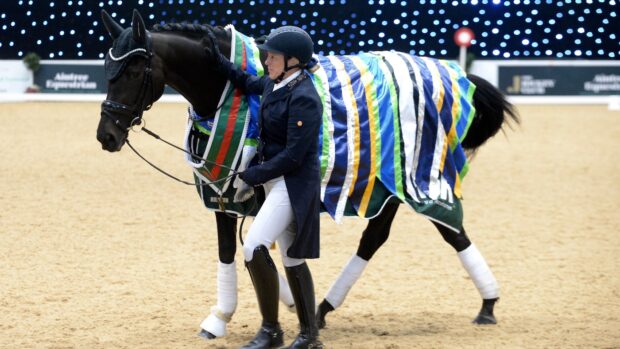Showing classes specifically for ex-racehorses have grown in popularity in recent years, as more and more horses take to the ring after careers on the track. If you’re looking to show your ex-racer this season, make sure your horse is correctly prepared to impress the judges with the following advice from leading experts and producers.
Who is eligible?
For Retraining of Racehorses (RoR) series, Thoroughbreds must have raced in Great Britain and be registered with Weatherbys. For SEIB Racehorse to Riding Horse classes, only Thoroughbreds who have raced under the rules of an approved racing authority recognised as such by the British Horseracing Authority rules can compete.
Tack and turnout
- A snaffle bit is acceptable for novice classes, so don’t feel you have to force your horse into a Pelham or a double bridle too soon.
- Leather should be plain and flat (ie not rolled). Coloured browbands are acceptable on a hack or riding horse-type, but not a hunter.
- Correctly fitting tack that is also suitable for a ride judge is important.
David Frogatt, ride judge for the SEIB racehorse finalists at Horse of the Year Show in 2015, says: “I am often disappointed to note a lack of understanding from riders about tack, turnout and presentation in hand.
“It spoils the overall picture when horses have a huge bridle smothering a quality head, carry ill-fitting saddles — some too small for the judge to sit on or get their feet into the stirrups — and when riders themselves are poorly turned out.”
- Gentleman should ride their ex-racehorse in a tweed jacket. For ladies, jackets should be navy or black on a hack type. For hunter or riding horse type, ladies should wear tweed a jacket.
- Breeches should be plain, fawn or buff, but not white.
- Wear an ordinary shirt with collar and tie. For an evening performance you will need a white or cream stock instead of a tie, with gentleman in a black or navy jacket.
- Boots should be black or brown.
- Gloves should be plain, ideally leather or string.
- Spurs are considered correct dress for adult riders, but they are optional.
- You should carry a whip that is plain Malacca or a leather cane and not exceeding 32” in length. Schooling whips are not allowed.
Show day
It is worth watching a class before competing yourself in order to see what happens and pick up tips.
“There is a lot of help out there; producers are keen to give advice and there are good clinics to go to,” says producer Lynn Russell.
After an initial ‘go-round’ where all the horses in the arena walk, trot and canter together, judges pull the horses into line in order of preference.
In novice classes, riders are then expected to give an individual show that includes walk, trot and canter with at least one change of rein. This is your chance to show off your horse with the judges’ full attention, and a well-schooled horse will fare best.
In open classes, a ride judge would take over for the individual show.
There is no galloping in either category.
Horses will also be stripped off and their conformation assessed by a judge. Where entries are low, one judge may do both the ridden and conformation assessments.
It is important to remember, warns Lynn, that “it’s not just a case of seeing a racehorse class and entering it. Horses have to be properly prepared for the ring”.
Top tips for being prepared
1. Standing still is not one of the strongest attributes of ex-racehorses, so patience is needed, especially when mounting. Most will be accustomed to their jockeys being legged up as they move off, a habit that takes time to break.
“With fidgety horses I use a mounting block and have two helpers – one to make a fuss of the horse, and the other to hold the stirrup,” says Lynn. “Practice makes perfect and horses learn through repetition, but you must be consistent with what you expect of them. Reward the horse when they stand still so that they understand that that is good behaviour and they will be rewarded for it.”
2. Practice trotting your horse up in hand — it’s surprisingly harder to do than you might thing. They should trot alongside you — not be pulled along — and without trying to bite you. They must stay straight through their body rather than becoming curved and crooked.
“Most of the time horses will trot back with you, but don’t take it for granted. You need to practice,” advises Katie Jerram, who has won many ex-racehorse titles aboard HM The Queen’s Barbers Shop.
3. Make sure your horse is used to being ridden by other people, so that the ride judge does not come as a surprise to them.
“We must never lose sight of the fact that we are being asked to ride an ex-racehorse and sometimes it’s like taking your life in your hands,” adds Lynn, who also ride judges these classes. “Quite often, six horses will give decent rides and the rest have not been educated at all.”
4. School and educate your horse at home, ideally with the help of a trainer.
“It is quite off putting when riders tell you their horse has only just finished racing,” admits David Frogatt.
“Ex-racers tend to give judges a bit more to do as they can still be quite sharp and it can be a case of sitting still and nursing them along.
They don’t tend to be as soft in the mouth or bend to your leg in the same way hunters, hacks and riding horses do, but I have been pleasantly surprised to be given good rides from horses at the bottom of the line.
The initial ‘go round’ together can be quite an ordeal and while many horses light up at this stage, some are a delight to ride on their own.”
Like this? You might also enjoy reading these:
Spencer Wilton’s tips to improve your ex-racehorse’s dressage marks
Subscribe to Horse & Hound magazine today – and enjoy unlimited website access all year round
What does the judge want to see?
“I like to see a quality walk and a happy horse move lightly through its paces,” explains David.
Aim to demonstrate that your ex-racehorse is safe, well-mannered, obedient and a pleasure to ride.
The RoR website states: “this means no pulling, no head-tossing and so on. The horse should work in a soft, consistent, rounded outline. The judge will assess whether he/she considers your horse has adapted well to life as a riding horse and is settled in the show ring.”
Where to compete?
All major shows usually have some form of ex-racehorse series.
The biggest accolades an ex-racehorse can win are the SEIB Racehorse 2 Riding Horse final held at Horse of the Year Show (HOYS) in October, as well as the RoR Tattersalls Show Series Championship and RoR Goffs UK National Championships.
In 2019, the SEIB Racehorse 2 Riding Horse winner was Grandeur (Jo Bates) while Desert Joe (Rebecca Court) landed the RoR Tattersalls Show Series at Hickstead in June and Mumford (Collette McGoldrick) was crowned Supreme Champion at the RoR Goffs UK National Championships at Aintree in August.
Horse & Hound magazine, out every Thursday, is packed with all the latest news and reports, as well as interviews, specials, nostalgia, vet and training advice. Find how you can enjoy the magazine delivered to your door every week, plus options to upgrade to access our H&H Plus online service which brings you breaking news as it happens as well as other benefits.




